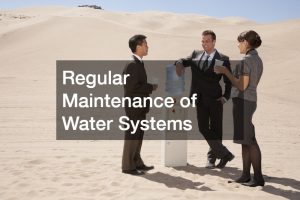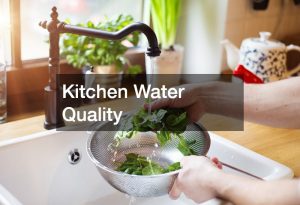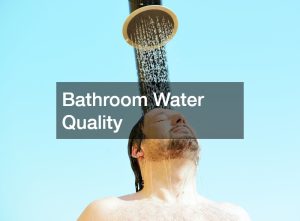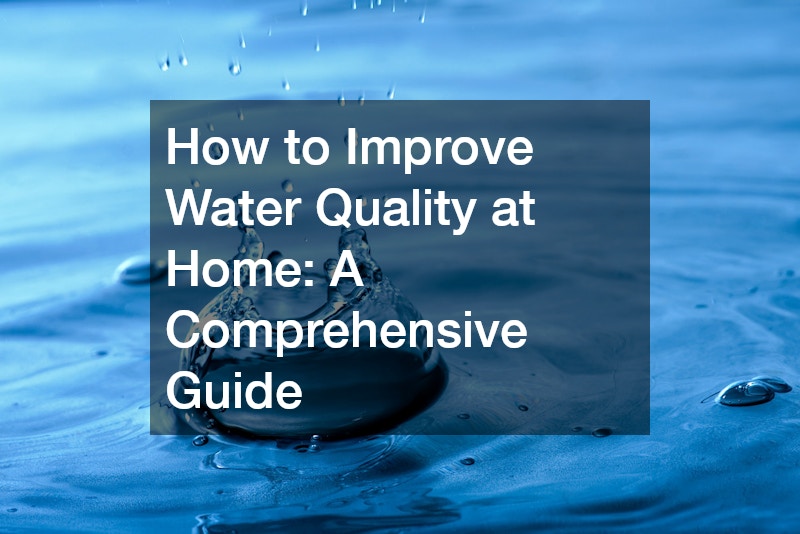Introduction
For homeowners, water quality is a critical aspect that impacts daily life, influencing health, comfort, and efficiency. The quality of water can vary significantly, commonly influenced by contaminants, infrastructural issues, and natural elements. Addressing water quality not only enhances health outcomes by minimizing exposure to harmful substances but also improves taste and odor, extending the longevity of household appliances.
As homeowners become increasingly aware of the significance of water quality, the demand for improved water systems and treatment methods grows. This guide will delve deeper into water quality, testing methods, filtration systems, maintenance practices, and actionable strategies that homeowners can implement to enhance the quality of water in their homes.
1. Understanding Water Quality
1.1 What Is Water Quality?
Water quality refers to the chemical, physical, and biological characteristics of water. These indicators provide insight into its suitability for various functions, such as consumption, cleaning, and equipment usage. Key parameters to assess water quality include:
- pH Levels: The acidity or alkalinity of water, which can affect the taste and usability.
- Hardness: The concentration of minerals like calcium and magnesium can impact everything from soap effectiveness to the lifespan of appliances.
- Contaminants: The presence of harmful substances, including heavy metals, bacteria, and chemical pollutants.
Maintaining optimal water quality involves monitoring these factors regularly to ensure ecological and human health. For instance, water with a pH below 6.5 can corrode pipes, while water with a pH above 8.5 can taste bitter and affect household cleaning products’ effectiveness.
1.2 Common Contaminants Found in Home Water Supplies
Many household water supplies may contain contaminants that can pose health risks. These include:
- Bacteria and Viruses: Pathogens can enter water supplies through contamination from sewage or agricultural runoff.
- Heavy Metals: Metals like lead and copper can leach into drinking water from old plumbing systems.
- Chlorine and Chloramines: Used as disinfectants, these can impart an unpleasant taste and odor.
- Sediments: Particulates like dirt and sand can originate from source water or deteriorating pipes.
Understanding these contaminants allows homeowners to take informed steps toward mitigating their presence and ensuring clean, safe water.
2. Testing Your Water Quality
2.1 Why You Should Test Your Water
Regular water testing is essential for ensuring the water’s safety and quality. Knowing your water composition helps address health implications from contaminants and aligns with local safety regulations. Some benefits of regular testing include:
- Health Protection: Early detection of contaminants can prevent serious health issues.
- Regulatory Compliance: Many localities have regulations regarding water quality; testing can ensure compliance.
- Peace of Mind: Knowing your water is safe can relieve concerns about daily use.
Keeping up with periodic testing ensures that homeowners are aware of changes in water quality that might go unnoticed until major issues arise.
2.2 Types of Water Testing Kits
Water testing kits come in various types and are suited for different needs and accuracy levels. Here are some common options:
- Home Testing Kits: These kits are convenient for quick checks, and they often test for pH, hardness, chlorine levels, and some contaminants. They usually provide instant results but may not be comprehensive.
- Professional Testing Services: For a more precise analysis, hiring a water testing service is advisable. These services can provide detailed reports on a wide range of contaminants and recommend appropriate solutions.
- Laboratory Testing: Collecting water samples and sending them to a certified laboratory offers the most thorough analysis, covering heavy metals, biological contaminants, and more.
Key parameters to examine include the presence of contaminants, pH levels, and mineral content to ensure water is up to standards. Homeowners should consider the best testing method based on their specific needs and concerns.
3. Ways to Improve Water Quality
3.1 Installing Water Filtration Systems
Implementing water filtration systems can significantly improve water quality by removing impurities and enhancing taste. Various types of filtration systems include:
- Activated Carbon Filters: Effective at removing chlorine, sediment, and volatile organic compounds (VOCs). They enhance taste and odor but may not remove heavy metals.
- Reverse Osmosis Systems: These systems use a semi-permeable membrane to remove a wide range of contaminants, including heavy metals, salts, and microorganisms. While effective, they may waste some water during the filtration process.
- Ultraviolet (UV) Filters: UV systems kill bacteria and viruses but do not remove chemical contaminants. They are often used in conjunction with other filtration methods for comprehensive treatment.
Homeowners should evaluate their specific water needs to choose the appropriate filtration system, often considering product recommendations as well. Installation may require professional help, especially for more complex systems.
3.2 Regular Maintenance of Water Systems

Proper maintenance of water systems is crucial to ensure their effectiveness in improving water quality. Here are some maintenance tips:
- Change Filters Regularly: Follow the manufacturer’s guidelines for changing filters to prevent bacteria buildup and maintain filtration efficiency.
- Flush Systems: Periodically flushing systems can help remove sediment and other impurities that may accumulate over time.
- Inspect for Leaks: Regularly check connections and pipes for leaks that could introduce contaminants into your water supply.
Keeping up-to-date with maintenance extends the life of the installed systems and sustains their protective benefits. Documenting maintenance schedules can help ensure no tasks are overlooked.
4. Improving Water Quality at the Source
4.1 Contacting Your Water Utility
For a deeper understanding of water quality issues, homeowners should contact their local water utility. Here’s how to engage with your utility effectively:
- Request Water Quality Reports: Utilities are required to provide annual water quality reports. These documents detail contaminants present in the water supply and compliance with safety standards.
- Inquire About Recent Changes: Ask about any recent changes to water treatment processes or infrastructure that may affect water quality.
Utilities are often willing to share information that can pinpoint specific areas of concern for any household within their jurisdiction.
4.2 Rainwater Harvesting and Treatment
Rainwater harvesting is an eco-friendly method to supplement the water supply and improve water quality. Here are some considerations for homeowners interested in this practice:
- Collecting Rainwater: Install a rainwater collection system, including gutters, downspouts, and storage tanks. Ensure that all equipment is food-grade and safe for collecting potable water.
- Treatment Methods: The collected rainwater should be treated through basic methods like filtration and purification before use. Options include UV sterilization, activated carbon filters, and chemical treatments (e.g., chlorine).
Rainwater harvesting reduces reliance on municipal supplies and minimizes contaminants at the source, offering an alternative water source for irrigation, toilets, and other non-potable uses.
5. Maintaining Plumbing and Fixtures
5.1 Regular Inspection of Pipes and Plumbing
Systematic inspection of pipes and plumbing helps identify potential causes of water quality degradation. Here are some key practices:
- Look for Corrosion: Check for signs of rust or corrosion on pipes, which can leach harmful elements into the water supply.
- Address Leaks Promptly: Small leaks can introduce contaminants and lead to significant water damage if left untreated.
Regular maintenance ensures that the infrastructure remains efficient and safe for household use.
5.2 Replacing Old Fixtures
Outdated faucets and showerheads can adversely affect water quality, often leaching harmful elements into the water. Homeowners should consider the following:
- Upgrade to Modern Fixtures: Modern, water-efficient fixtures are designed to minimize water wastage and can significantly reduce contamination risks.
- Check for Lead: If your plumbing system includes older fixtures, especially those made before 1986, consider replacing them with lead-free options to prevent exposure.
Making such changes is a proactive way to enhance water quality and improve the overall function of residential water systems.
6. Enhancing Water Quality in Specific Areas
6.1 Kitchen Water Quality

In the kitchen, clean water is crucial for cooking and drinking, impacting taste and safety. Here are some best practices:
- Maintain Spout Cleanliness: Regularly clean faucet aerators and spouts to prevent bacterial growth.
- Use Filtration Systems: Ensure that your kitchen tap has a reliable filtration system in place for drinking and cooking water.
- Monitor Ice Makers: Clean and maintain ice makers and dispensers to ensure they produce clean ice.
Regularly updating kitchen water systems can prevent lingering quality issues, contributing to a healthier household environment.
6.2 Bathroom Water Quality

Maintaining bathroom water quality is essential to avoid potential health risks, particularly from common pathogens. Here are ways to ensure high water quality:
- Regular Cleaning: Use appropriate cleaning agents to maintain fixtures, preventing mold and bacteria buildup.
- Upgrade Shower Filters: Installing filters on showerheads can reduce chlorine exposure and improve skin and hair health.
- Inspect Toilets: Regularly check for leaks or corrosion in toilets that may compromise water quality.
Ensuring that shower filters are replaced and fixtures are well-maintained limits the spread of contaminants, fostering a healthier bathroom environment.
7. Additional Tips for Homeowners
7.1 Educating Family Members on Water Safety
Family-wide awareness and education for water safety is indispensable for comprehensive water quality improvement. Here’s how to foster a culture of water safety:
- Teach Children About Water Safety: Discuss the importance of clean water, why it matters, and how they can contribute to maintaining water quality.
7.1 Educating Family Members on Water Safety
Fostering a culture of water safety in your home is essential for ensuring everyone understands the importance of clean water. Here are some strategies to educate family members:
- Discuss the Importance of Clean Water: Hold family discussions about why water quality matters, emphasizing its effects on health and daily life. Use relatable examples to illustrate the consequences of poor water quality, such as illness or unpleasant taste in drinking water.
- Encourage Involvement in Water Testing: Involve family members in the process of testing water. This hands-on experience helps them understand the various components of water quality and why monitoring them is important.
- Share Resources: Provide educational materials, such as pamphlets or websites, that explain water quality issues, potential contaminants, and the importance of clean water. Encourage family members to ask questions and express concerns about water quality.
7.2 Creating a Water Quality Improvement Plan
A structured approach can significantly enhance water quality in your home. Consider developing a comprehensive water quality improvement plan that includes:
- Assessing Current Water Quality: Start with testing your water to identify specific contaminants and issues. Document these findings for future reference.
- Setting Clear Goals: Based on your assessment, outline specific goals for improving water quality. This could include reducing chlorine levels, addressing lead contamination, or enhancing the taste and odor of water.
- Implementing Changes: Based on the identified goals, implement necessary changes such as installing filtration systems, replacing old plumbing fixtures, or practicing rainwater harvesting.
- Monitoring Progress: Regularly retest your water to monitor improvements. Adjust your plan as needed to continue enhancing water quality.
Creating a systematic plan empowers homeowners to take control of their water quality, ensuring a healthier living environment for their families.
8. Conclusion
Improving water quality at home is a multifaceted process that involves understanding the factors influencing water quality, testing for contaminants, implementing filtration systems, and maintaining plumbing infrastructure. By taking proactive steps, homeowners can significantly enhance the safety and quality of their water, leading to better health outcomes and improved household satisfaction.
Regular testing, system maintenance, and education are essential components of this ongoing effort. As water quality issues become more prevalent, homeowners equipped with knowledge and tools can effectively combat these challenges, ensuring their families have access to clean, safe water.
By committing to these practices and fostering a culture of awareness, homeowners can protect their health and improve their quality of life, making clean water a fundamental aspect of their home environment.
References
- United States Environmental Protection Agency (EPA). (n.d.). Water Quality Standards. Retrieved from EPA Water Quality Standards
- Centers for Disease Control and Prevention (CDC). (n.d.). Drinking Water Quality. Retrieved from CDC Drinking Water Quality
- Water Quality Association (WQA). (n.d.). Water Testing. Retrieved from WQA Water Testing
